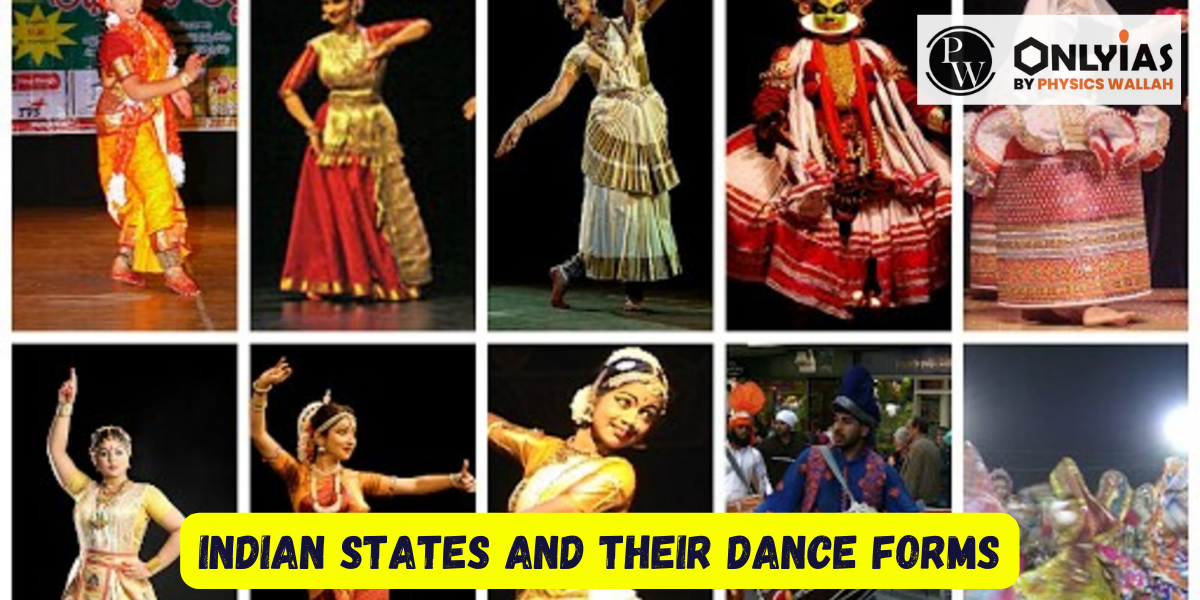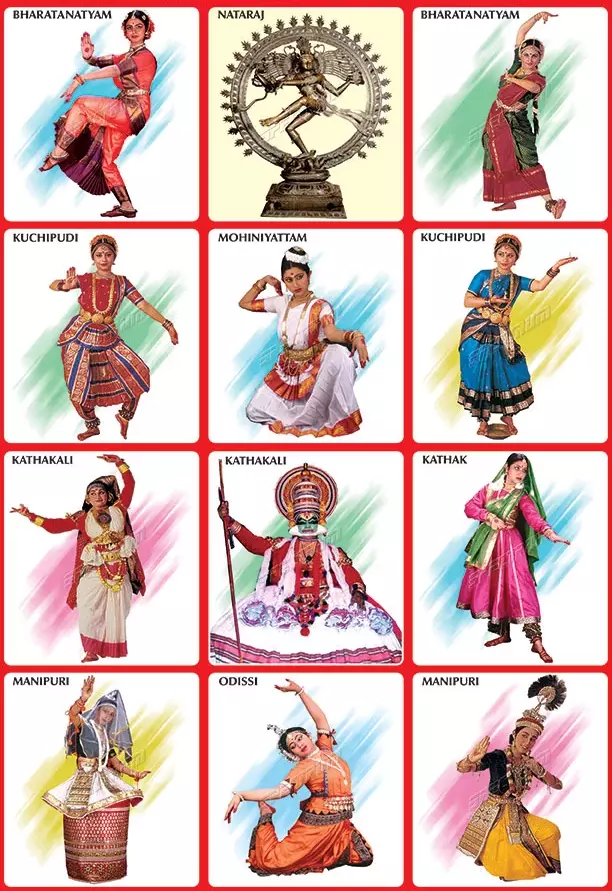
Indian States and their Dance Forms: Art and culture hold significant importance in the growth and development of a nation. They not only reflect the identity and heritage of a country but also play a crucial role in establishing diplomatic relations with other nations. Throughout history, art has been an integral part of human existence and has had a profound impact on society.
Art, in its various forms such as visual arts, music, dance, literature, and theater, has been a medium of expression and communication. It allows individuals to convey their thoughts, emotions, and experiences, transcending language and cultural barriers. Artistic creations have the power to inspire, provoke, and evoke a range of emotions, fostering creativity, critical thinking, and empathy among individuals.
Enroll now for UPSC Online Course
Dance holds a prominent place in Indian culture and is classified into two major forms: classical and folk dance. The fundamental distinction between these forms lies in their origin and style.
Classical Dance in India Classical dance traces its roots back to the ancient treatise Natya Shastra, where specific characteristics of each classical dance form are elaborated. There are traditionally 8 recognized classical dance forms in India, as per scholars and sources.
The Ministry of Culture in India has recently included Chhau in the list of classical dances, making it a total of 9 classical dance forms.
Enroll now for UPSC Online Classes
Classical dance expresses 8 basic emotions, known as “Navarasas,” which include:
Folk Dance in India In contrast, folk dance evolves from the local traditions and customs of specific states, ethnic groups, or geographical regions. Each region boasts a rich diversity of folk dances, reflecting the cultural diversity of the country.
Indian Dances with States – Important Static GK Topic Knowledge about Indian dances and their associated states is crucial for competitive exams like the UPSC. Understanding the various dance forms helps in appreciating India’s cultural heritage and artistic expression. In India, the art of dance encompasses two broad categories: Classical and Folk dance forms, each with its distinct characteristics and significance.
Below is a state-wise list of major dance forms in India along with a brief introduction. India’s dance forms are deeply rooted in the cultural heritage of each state, showcasing a variety of traditions, rituals, and artistic expressions.
| State | Major Dance Forms |
| Andhra Pradesh | Burrakatha, Kuchipudi, Veeranatyam, Kolattam, Butla Bommalu |
| Arunachal Pradesh | Wancho, Digaru Mishmi Buiya, Idu Mishmi, Ka Fifai, Ponung |
| Assam | Bihu, Bhortal, Dhuliya, Apsara-Sabha, Deodhani |
| Bihar | Bidesiya, Fagua, Kajari, Painki, Jhumri |
| Chhattisgarh | Saila Dance, Sau Nacha, Jhirliti, Karma, Panthi |
| Goa | Dhalo, Dhangar, Mussoll, Dashavatra, Dulpod |
| Gujarat | Garba, Matukadi, Dandiya Rass, Padhar, Siddi Dhamal |
| Haryana | Jhomar, Gangaur, Loor, Khoria, Sapela |
| Himachal Pradesh | Chamba, Rasa, Swang Tegi, Nuala, Jataru Kayang |
| Jharkhand | Santali, Mundari, Sarhul, Lahasua, Damkach |
| Karnataka | Kuchipudi, Bharatanatyam, Pata Kunitha, Veeragase, Yashagana |
| Kerala | Kathakali, Pulikalli, Thirvathirakali, Koodiyattam, Mohiniyattam |
| Madhya Pradesh | Muriya, Gaur, Saila, Ahiria, Banjara |
| Maharashtra | Lavani, Powada, Tamasha, Koli, Bala Dindi |
| Manipur | Lai Haraoba, Chanlam, Kartal Cholam, Rass Lila, Pung Cholam |
| Meghalaya | Wangala, Lahoo Dance, Pomblang Nongkrem, Derogata, Chambil Mesara |
| Mizoram | Cheraw, Chai-Lam, Khuallam, Solakai, Sarlamkai |
| Nagaland | Zeliang, Changai, Modse, War dance, Sadal Kekai |
| Odisha | Gotipua, Odissi, Dhap, Karma Naach, Dalkhai |
| Punjab | Giddha, Jhumar, Bhangra, Luddi, Jaago |
| Rajasthan | Bhavai, Fire Dance, Kalbelia, Rasiya, Tera Tali |
| Sikkim | Tamang Selo, Maruni, Chu Faat, Khukuri, Rechungma |
| Tamil Nadu | Theru Koothu, Kummi, Kolattam, Oyilattam, Puliyattam |
| Telangana | Gusadi, Kuchipudi, Lambadi, Dandaria, Bonalu |
| Tripura | Cheraw, Hojagiri, Mamita, Mosak Sulmani, Goria |
| Uttar Pradesh | Swang, Raslila, Nautanki, Kathak, Mayur Nritya |
| Uttarakhand | Romala, Jhora, Chhopati, Barada Nati, Dhurang |
| West Bengal | Chhau, Kalikapatadi, Jatra, Gazan, Dhunachi |
The classical dance forms in India have a rich heritage and can be traced back to the ancient Sanskrit text called the Natya Shastra. These dance forms are deeply rooted in the cultural and spiritual traditions of the country. They are characterized by intricate footwork, graceful movements, expressive gestures, and elaborate costumes.
Some of the prominent classical dance forms in India include:
1. Bharatanatyam: Originating in the state of Tamil Nadu, Bharatanatyam is known for its precise footwork, intricate hand gestures, and elaborate facial expressions. It is a dance form that embodies both storytelling and devotion.
2. Kathak: Developed in Northern India, Kathak is known for its graceful movements, fast spins, and rhythmic footwork. It blends elements of storytelling, music, and rhythmic patterns.
3. Odissi: Hailing from the state of Odisha, Odissi is characterized by fluid movements, intricate postures, and expressive facial expressions. It is deeply rooted in the stories and mythology of the region.
4. Kathakali: A traditional dance-drama from Kerala, Kathakali involves elaborate makeup, costumes, and facial expressions. It combines dance, music, and drama to depict mythological stories.
Folk dances in India are a reflection of the vibrant cultural diversity and regional traditions. They are performed on various occasions and celebrations and are characterized by energetic movements, colorful costumes, and infectious music.
Here are a few popular folk dance forms from different states in India:
1. Bhangra: Originating in Punjab, Bhangra is a lively and energetic dance form performed during harvest festivals. It involves vigorous movements, vibrant costumes, and the beats of traditional Punjabi music.
2. Garba: Hailing from the state of Gujarat, Garba is performed during the Navratri festival. It involves circular formations, graceful hand movements, and rhythmic footwork.
3. Bihu: Native to the state of Assam, Bihu is performed during the Bihu festival. It is characterized by fast-paced movements, vibrant costumes, and energetic music.
4. Ghoomar: Popular in Rajasthan, Ghoomar is a graceful dance form performed by women. It involves spinning movements, twirling skirts, and intricate hand movements.
1. Bharatanatyam (Tamil Nadu): Bharatanatyam is a classical dance form that originated in Tamil Nadu. It is known for its intricate footwork, expressive hand gestures (mudras), and intricate facial expressions. The dance form tells stories from Hindu mythology and is performed with Carnatic music.
2. Kathak (Uttar Pradesh, Rajasthan): Kathak is a classical dance form that is popular in Uttar Pradesh and Rajasthan. It involves fast footwork, spins, and graceful movements. Kathak is known for its storytelling aspect and is accompanied by Hindustani classical music.
3. Odissi (Odisha): Odissi is a classical dance form that originated in the state of Odisha. It is characterized by fluid movements, intricate postures, and expressive facial expressions. Odissi is performed to classical Odia music and often narrates stories from Hindu mythology
4. Kathakali (Kerala): Kathakali is a traditional dance-drama form from Kerala. It combines dance, music, and acting to depict mythological stories. The performers wear elaborate makeup, costumes, and headgear. Kathakali involves intricate facial expressions and bold body movements.
5. Mohiniyattam (Kerala): Mohiniyattam is a classical dance form from Kerala, primarily performed by women. It is known for its graceful movements, subtle facial expressions, and flowing costumes. Mohiniyattam incorporates elements of dance, music, and mime.
6. Manipuri (Manipur): Manipuri is a classical dance form from Manipur. It is characterized by gentle, graceful movements and intricate footwork. Manipuri dance is often performed in a circular pattern and has elements of storytelling, devotion, and regional folk traditions.
7. Sattriya (Assam): Sattriya is a classical dance form from Assam, traditionally performed by male monks in the monasteries (sattras). It combines elements of dance, drama, and music to depict stories from Hindu mythology. Sattriya involves rhythmic footwork, graceful hand movements, and facial expressions.
8. Bhangra (Punjab): Bhangra is a popular folk dance form from Punjab, known for its energetic and lively movements. It is performed during harvest festivals and celebrations. Bhangra involves vibrant costumes, vigorous footwork, and rhythmic clapping.
9. Garba (Gujarat): Garba is a folk dance form from Gujarat, primarily performed during the Navratri festival. It involves circular formations, graceful hand movements, and rhythmic footwork. Garba is accompanied by traditional Gujarati music and is performed with great enthusiasm.
10. Chhau (West Bengal, Odisha, Jharkhand): Chhau is a traditional dance form found in the eastern states of West Bengal, Odisha, and Jharkhand. It incorporates martial arts movements, acrobatics, and storytelling. Chhau is performed with elaborate masks and costumes.

Art and culture contribute to the economy by promoting tourism, generating employment opportunities, and boosting the creative industries. They serve as a means of preserving and celebrating a country’s traditions, customs, and values, creating a sense of pride and unity among its people. Cultural exchange programs and collaborations between nations through art foster mutual understanding, respect, and appreciation for diverse cultures.
Art and culture also have therapeutic and healing effects, providing solace, inspiration, and a sense of belonging to individuals. They contribute to personal and social well-being, promoting cultural diversity, social cohesion, and inclusivity within societies.
Sign up for the PWOnlyIAS Online Course by Physics Wallah and start your journey to IAS success today!
|
Related Articles |
|
| Classical Dances Of India | Indian Folk Dances |
| Festivals Of India | National Postal Week and World Post Day 2024 |
| International Girl Child Day 2024 | World Food Day 2024 |
<div class="new-fform">
</div>
